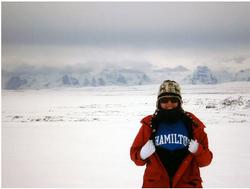Features
Students sail to Antarctica on the LM Gould
By Lindsey Luker '15
November 8, 2012
This Friday, two Hamilton students and two alumni returned from an 18-day cruise to Antarctica with Principal Investigator Eugene Domack, the J.W. Johnson Family Professorship of Environmental Studies. Deanna Nappi ’15, Katy Smith ’13, Garrett Akie ’12 and University of South Florida Ph.D palaeoceanographer, Professor Amelia Shevenell ’96 boarded the LM Gould on Oct. 10th with several initiatives in mind. They have worked in the Hamilton sedimentary geology lab before, but they jumped on the opportunity to gain real-life experience and a familiarity with the sample collection process.
As part of the LARISSA (LARson Ice Shelf System, Antarctica) Project, Hamilton’s Antarctic team set off to install a continuous GPS station, just the seventh of its kind, at Spring Point on the Antarctic Peninsula. Smith explains how the cGPS stations “continuously transmit meteorological data and elevation data so that [researchers] can quantify crustal rebound and see how it relates to warming and the loss or gain of ice mass on the Peninsula.”
The crew underwent rough seas in crossing Drake’s Passage, an area known for its towering waves and high-speed winds. After facing even harsher weather conditions and seasickness – all the while releasing drifter samples to test for speed, salinity and sea surface temperature, among other things – they arrived at Copacabana field camp to drop off a separate group studying penguin populations on King George’s Island. There, the Hamilton group prepared their cGPS station for deployment and set foot on solid ground for the first time in four days to explore the field camp amidst penguins and elephant seals.
The LM Gould was unable to access Spring Point due to brutal weather conditions and an impassable band of pack ice. Instead, the crew rerouted to Duthiers Point on the Andvord Bay, where their new mission was to replace the modem on an existing cGPS. Loaded with gear, the group boarded zodiac boats, commuted to land and made the treacherous climb to the solar-powered cGPS. Their work on the modem lasted about four hours.
“Now,” Akie explains, “the solar powered cGPS station will continue to transmit elevation data. The data measures crustal rebound as the land rises in response to post-glacial isostasy. This cGPS station has the fastest rate of uplift on the entire continent at two cm/year. Two cm/year may seem minute, but geologically speaking it is quite remarkable.”
In addition to their work on the Duthiers Point cGPS, the crew collected ocean floor sediment core from several different sites around the Bruce Plateau Ice Dome. It was an elaborate and exhausting process that required the participation of everyone aboard the LM Gould. They analyzed these samples immediately upon collecting them, which proved to be most challenging on unstable footing in disagreeable seas. Gene Domack, who is no stranger to the Antarctic seas, also recruited the Hamilton team to test some of his samples from previous excursions.
Within the first week of the expedition, the students saw the physical repercussions of climate change. Domack pointed out a certain type of glacier melting that appeared in the West Antarctic Peninsula within the last two decades. It was an eye-opening experience for some team members to see the physical, tangible effects of global warming for the first time.
Though the voyage was undoubtedly a remarkable one, it was nonetheless draining. The Hamilton Antarctic team worked day and night shifts, sometimes working for over 17 hours without a break. The unpredictable, ever-changing weather conditions made it imperative that the group complete projects in a timely manner.
“There were some pretty stressful moments,” the team reported, “but we loved every minute of it.”
The team gained a huge appreciation for all of the work that goes into collecting samples – the behind-the-scenes aspects that many people, students especially, take for granted.
“We are extremely privileged and grateful to be part of this experience with such great and talented professors, technicians and other specialists.”
The specialists included Domack, Shevenell, and Brad Rosenheim, a geochemistry professor at Tulane University.
The Hamilton team is exceptionally thankful to have gained hands-on experience in their field. They attribute their success not only to the professionals and students on board, but also to the marine technicians and to Earnest, the captain of the LM Gould.
“To be part of such an amazing experience and an important project, the LARISSA project, as undergraduates is an opportunity that not many schools can offer.”

No comments yet.
Comment Guidelines
Please log in to post a comment